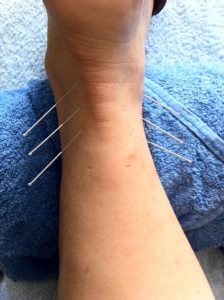Dry Needling May be Your Solution to Nagging Injuries
What is dry needling?
 Dry needling is a technique used by physical therapists to decrease pain, speed recovery and minimize downtime.
Dry needling is a technique used by physical therapists to decrease pain, speed recovery and minimize downtime.
The technique helps to “reset” muscles that have been damaged during training, racing, overuse, or poor mechanics in daily activities. This reset is performed on trigger points which can impair the neuromuscular and musculoskeletal performance of our bodies.
What are trigger points and how to they happen?
Trigger points are tightened bands of tissue caused by injury, overuse or new activities which can result in pain and impaired movement patterns. This can be detrimental to activities such as swimming, cycling, or running.
During any exercise or activity, but especially during intense or repetitive exercise, muscle damage occurs on a cellular level. It has been proposed that this muscle damage causes an imbalance in the chemical makeup within the muscle fibers and this imbalance results in persistent muscle fiber contraction and increased sensitivity to touch. This trigger point can be a source of pain, limited range of motion and muscle inhibition.
Dry needling releases these taut bands and trigger points and restores the chemical balance in the muscle fibers, reducing pain and improving function.
How does dry needling work?
Based on symptoms, an experienced physical therapist can palpate painful and non-painful trigger points as well as taut bands of tissue in individual muscles. Then the physical therapist uses a thin monofilament needle to release the trigger point or taut band, allowing muscles to function properly and with less pain.
How can dry needling help me?
When those trigger points are released, it results in improved gait patterns, stronger muscle contractions, and more productive workouts.
5 common trigger point areas that endurance athletes experience include:
- Hip: glutes, piriformis, deep rotator muscles (hip bursitis, IT Band syndrome)
- Lumbar (low back): QL (quadratus lumborum) and paraspinal muscles (sciatica)
- Thigh: quads and hamstrings (IT Band syndrome, runner’s knee)
- Calf/foot: gastroc, soleus, peroneals, posterior/anterior tibialis (plantar fasciitis, shin splints)
- Neck/shoulders: traps, pectorals, lats (shoulder impingement, rotator cuff syndrome)
Addressing these trigger points with dry needling, along with a formal assessment of your strength, range of motion, and mechanics by an experienced and knowledgeable physical therapist can help you achieve or return to optimal pain free performance.
How does dry needling differ from acupuncture?
According to Physical Therapists & the Performance of Dry Needling: An Educational Resource Paper by the APTA,
“The practice of acupuncture by acupuncturists and the performance of dry needling by physical therapists differ in terms of historical, philosophical, indicative, and practical context. The performance of modern dry needling by physical therapists is based on western neuroanatomy and modern scientific study of the musculoskeletal and nervous system. Physical therapists who perform dry needling do not use traditional acupuncture theories or acupuncture terminology.”*
Dry needling is not just for athletes. It can benefit anyone who is limited by pain or injury in their daily activities.
Why wait? Schedule your dry needling session today with Jon Paryz, PT of Stay Strong Physical Therapy & Wellness. He see clients on Thursday evenings from 4-8pm and some Saturdays.
If you have any questions, contact Jon at (919) 414-7475 or email him at staystrongptwellness@gmail.com.



